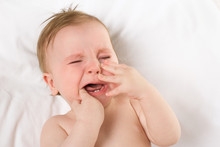Safely soothe the teething pain of infants and children
U.S. Food and Drug Administration (FDA)
Teething is a normal experience for infants and children, but it can be painful. Many well-meaning parents and caregivers who want to ease a child’s pain might turn to products that could be harmful.
Soothing children’s gums with prescription or nonprescription medicines containing benzocaine or lidocaine – or homeopathic tablets and other products – might seem like good options. The U.S. Food and Drug Administration warns that these products can be dangerous to children and can lead to serious injury, and even death.
The American Academy of Pediatrics (AAP) recommends alternative ways for treating teething pain, including rubbing infants’ gums with a clean finger, or providing a teething ring made of firm rubber to chew on. On average, infants begin teething around age 4 to 7 months and have a total of 20 “baby teeth” by 3 years of age. According to the AAP, occasional symptoms of teething include mild irritability, a low-grade fever, drooling, and an urge to chew something hard.
Topical Drugs and Teething Jewelry Used for Teething Have Risks
Topical medications (used on the surface of the gums) containing benzocaine or lidocaine offer little to no benefit and are associated with serious risks when used for teething pain in children. These include creams, gels, and homeopathic teething tablets.
Benzocaine, a local anesthetic (a drug that temporarily numbs), is the active ingredient in several nonprescription oral health care products, including Anbesol, Cepacol, Chloraseptic, HurriCaine, Orabase, Orajel, and Topex. These products should not be used for teething pain in children because they can be dangerous. Using benzocaine products can lead to a serious, and sometimes fatal, condition called methemoglobinemia, in which the oxygen-carrying capacity of red blood cells is greatly reduced.
Topical oral viscous lidocaine solution – a prescription drug used to treat certain types of mouth pain – also should not be used to treat teething pain in infants and young children. It can cause grave harm, such as heart problems, severe brain injury and even death. In addition, topical oral viscous lidocaine solution can cause seizures in infants and young children when too much is applied, or it is accidentally swallowed.
The FDA also has received reports of death and serious injuries to infants and children, including strangulation and choking, caused by teething jewelry, such as amber teething necklaces.
What You Can Do to Ease Teething Pain
If a child’s gums are swollen and tender, gently rub or massage the gums with your finger, or give the child a firm (not liquid-filled) teether made of rubber to chew on. Make sure the teething ring is not frozen. If the object is too hard, it can hurt the child’s gums. Be sure to supervise children so they don’t accidentally choke on the teething ring.
